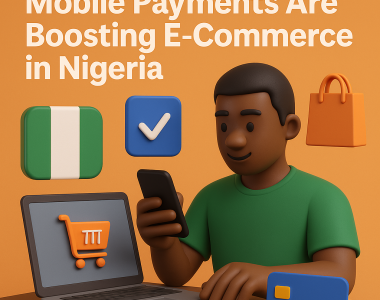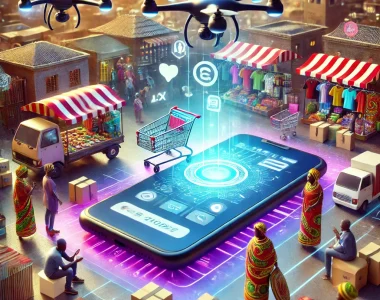
The Future of E-Commerce in Africa: Key Trends to Watch
Africa’s e-commerce landscape is rapidly evolving, driven by increased internet access, mobile penetration, and a burgeoning middle class. The continent is experiencing a wave of digital transformation, making it an exciting space for businesses, entrepreneurs, and consumers alike. Let’s dive into some of the key trends shaping the future of e-commerce in Africa, while discussing the implications and opportunities these trends present.
1. Mobile-First E-Commerce
With over 800 million mobile users across Africa, mobile-first e-commerce is becoming a dominant trend. Mobile phones are often the primary means of accessing the internet, especially in remote areas where desktop computers are not as prevalent. This is pushing e-commerce platforms to prioritize mobile optimization, ensuring seamless browsing, purchasing, and payments through mobile devices.
Key Points to Consider:
- Mobile payment systems like M-Pesa and Flutterwave are facilitating cashless transactions, making it easier for consumers to shop online.
- Many Africans now prefer shopping through mobile apps because of the ease and speed they offer.
Resources to explore:
2. The Rise of Digital Payments
In Africa, cash has traditionally been king. However, as e-commerce grows, there is a shift toward digital payment solutions. Digital wallets, mobile money services, and online banking are becoming more common and reliable for online transactions.
Payment systems like Paystack and Paga have made it easier for both consumers and merchants to participate in e-commerce.
Key Points to Consider:
- Digital payments offer security and convenience for both buyers and sellers.
- Governments are encouraging cashless transactions as part of their economic digital transformation goals.
Resources to explore:
- Paystack: Empowering African businesses with payment solutions
- Paga: Simplifying payments across Africa
3. Local E-Commerce Platforms and Marketplaces
While global giants like Amazon and Alibaba are present in Africa, local e-commerce platforms are dominating the market. Platforms like Jumia, Takealot, and Konga are uniquely positioned to cater to the needs and preferences of African consumers. These local platforms are more familiar with regional challenges and offer tailored solutions.
Key Points to Consider:
- Local platforms focus on products that are in demand regionally, and they offer payment solutions adapted to local currencies and preferences.
- They also understand the local supply chains and the challenges of delivery in diverse African regions.
Resources to explore:
- Jumia: Africa’s largest e-commerce platform
- Takealot: South Africa’s leading e-commerce site
- Konga: Nigeria’s multi-product e-commerce site
4. Cross-Border E-Commerce
Africa’s e-commerce industry is increasingly becoming pan-African, with businesses reaching consumers in different countries across the continent. The Africa Continental Free Trade Area (AfCFTA) is facilitating easier trade between African nations, opening new markets for e-commerce businesses.
Key Points to Consider:
- E-commerce platforms are integrating logistics solutions that allow goods to move easily across borders.
- Local entrepreneurs and SMEs can now sell their products beyond their national borders, reaching the entire continent.
Resources to explore:
5. Social Commerce and Influencer Marketing
Social media is an essential part of daily life for millions of Africans. Social commerce, the practice of selling directly through social media platforms, is becoming a powerful tool for e-commerce businesses. Platforms like Instagram, Facebook, and TikTok are increasingly being used to promote and sell products.
Key Points to Consider:
- Influencers are playing a crucial role in shaping consumer behavior. They have a significant impact on how African consumers perceive products and services.
- Social commerce allows brands to build relationships with their audience and create a more personalized shopping experience.
Resources to explore:
6. E-Commerce Logistics and Last-Mile Delivery Solutions
One of the biggest challenges for African e-commerce is the logistics and delivery system, especially in remote or rural areas. Companies are now developing innovative delivery solutions, including the use of drones, motorcycles, and local courier networks to reach consumers.
Key Points to Consider:
- Jumia and Sokowatch have pioneered solutions to improve last-mile delivery, and other startups are emerging to tackle the challenge.
- Efficient logistics help reduce delivery times and costs, making online shopping more attractive for African consumers.
Resources to explore:
- Sokowatch: Revolutionizing last-mile delivery
- Jumia Logistics: Ensuring seamless delivery across Africa
7. E-Commerce and Sustainability
Sustainability is becoming a crucial factor in the global e-commerce landscape, and Africa is no exception. Green e-commerce initiatives, such as eco-friendly packaging, carbon offset programs, and ethical sourcing, are gaining traction.
Key Points to Consider:
- Younger African consumers are becoming more aware of environmental issues and are looking for brands that align with their values.
- E-commerce businesses can improve their image by adopting sustainability practices in packaging and supply chain management.
Resources to explore:
Conclusion: The Future is Bright for African E-Commerce
The African e-commerce market is full of potential and ripe for innovation. With increasing internet access, mobile penetration, and supportive government initiatives, the growth trajectory for e-commerce in Africa is only set to continue. By leveraging the key trends discussed above, businesses can tap into new markets, drive economic development, and make shopping more accessible for African consumers.
What excites you most about Africa’s e-commerce future? Which trends do you see having the biggest impact on your business or area of interest?
Feel free to share your thoughts or ask questions below!





